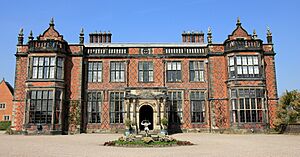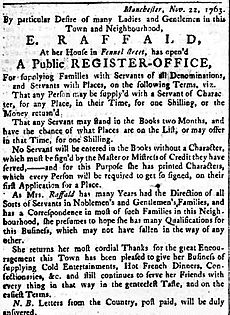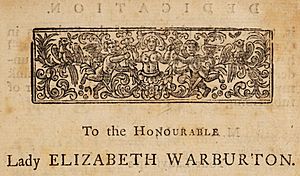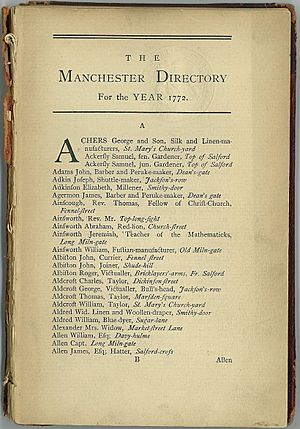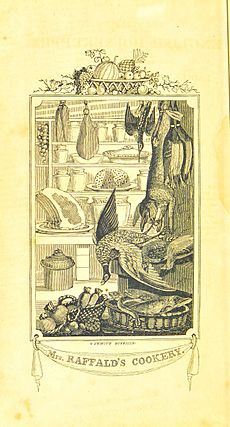Elizabeth Raffald facts for kids
Quick facts for kids
Elizabeth Raffald
|
|
|---|---|
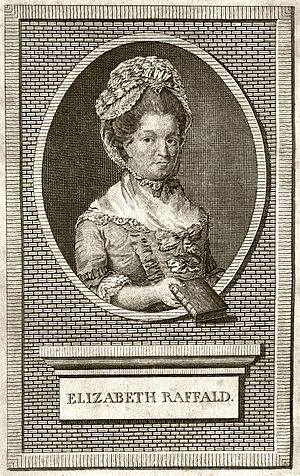
Engraving of Elizabeth Raffald, from her cookery book
|
|
| Born |
Elizabeth Whitaker
1733 Doncaster, England
|
| Died | 19 April 1781 (aged 47–48) Stockport, England
|
| Occupation | Housekeeper, businesswoman, author |
| Known for | The Experienced English Housekeeper (1769) |
Elizabeth Raffald (born Whitaker; 1733 – 19 April 1781) was a clever English author, inventor, and businesswoman. She created new ideas and ran several successful businesses.
Elizabeth grew up in Doncaster, Yorkshire. She worked for fifteen years as a housekeeper for a wealthy family at Arley Hall, Cheshire. She left her job when she married John Raffald, the head gardener there.
The couple moved to Manchester, Lancashire. Elizabeth opened an office to help people find jobs as domestic workers. She also ran a cooking school and sold food. In 1769, she published her famous cookery book The Experienced English Housekeeper. This book included the first recipe for a "Bride Cake" that looks like a modern wedding cake. Some people also believe she invented the Eccles cake.
In 1772, Elizabeth published The Manchester Directory. This was a list of 1,505 business owners and important people in Manchester. It was the first guide of its kind for the growing town. The Raffalds later managed two important inns in Manchester and Salford. They faced some financial problems, possibly due to John's spending habits. Elizabeth also started a business selling strawberries and hot drinks during the strawberry season. She passed away suddenly in 1781, just after publishing the third edition of her directory. She was also working on the eighth edition of her cookery book.
After her death, her cookery book was very popular. There were fifteen official editions and twenty-three copied versions. Other authors, like Isabella Beeton, copied many of Elizabeth's recipes. Modern chefs and food writers, such as Elizabeth David and Jane Grigson, still admire her recipes today.
Elizabeth Raffald's Life Story
Early Years and Work
Elizabeth Whitaker was born in Doncaster. She was one of five daughters. She was baptized on July 8, 1733. Elizabeth received a good education, even learning French.
At age fifteen, she began working as a kitchen maid. She slowly moved up to become a housekeeper. Her last job as a domestic servant was at Arley Hall, Cheshire. She worked there for Lady Elizabeth Warburton. Elizabeth started in December 1760 and earned £16 a year. She worked in service for fifteen years in total.
After a few years at Arley Hall, Elizabeth married John Raffald. He was the head gardener there. Their wedding was on March 3, 1763, at St Mary and All Saints Church in Great Budworth. On April 23, they left their jobs and moved to Fennel Street in Manchester. John's family grew vegetables nearby. Over the next few years, Elizabeth and John had several daughters. The girls had their own nurses and often wore clean white dresses when they went out. At least three of their daughters went to boarding schools.
Starting Her Businesses
John opened a flower shop near Fennel Street. Elizabeth began her own business ventures there. She rented out her extra rooms for storage. She also started a "register office" to connect domestic workers with employers for a fee. She advertised that she could provide "cold entertainments, hot French dishes, confectionaries," and more.
Over the next few years, her business grew. She added cooking classes to her services. In August 1766, the Raffalds moved to a larger place in Exchange Alley. Here, John sold seeds and plants. Elizabeth sold "jellies, creams, possets, flummery, lemon cheese cakes, and all other decorations for cold entertainments." She also sold hams, tongues, and various pickles. She even supplied food for and organized important city dinners.
In 1769, Elizabeth published her cookery book, The Experienced English Housekeeper. She dedicated it to Lady Warburton, her former employer. To publish the book, Elizabeth found "subscribers." These were people who paid for a copy in advance. The first edition had over 800 subscribers. This helped her raise more than £800. Subscribers paid five shillings when the book came out. Others paid six shillings.
Elizabeth said the book was "printed by a neighbour whom I can rely on." This neighbor was Joseph Harrop, who published the Manchester Mercury newspaper. Elizabeth had advertised a lot in his paper. She called writing the book a "laborious undertaking" that had made her tired. To stop others from copying her work, Elizabeth signed the front page of every copy of the first edition.
In her book's introduction, Elizabeth stated that her recipes were "from my own experience." She did not copy them from other authors. Like Hannah Glasse, another famous cookery writer, Elizabeth wrote in "plain language." Historians say that both Glasse and Raffald wrote with confidence. They were the best-selling cookery book authors in the Georgian era.
In 1771, Elizabeth released a second edition of her cookery book. It included 100 new recipes. A London publisher named Robert Baldwin bought the copyright for the book. He paid Elizabeth £1,400. When he asked her to change some of her local Manchester words, she refused. She said, "What I have written I proposed to write at the time; it was written deliberately, and I cannot admit of any alteration." More editions of her book were printed during her lifetime.
In May 1771, Elizabeth also started selling cosmetics from her shop. She sold lavender water, French soap, tooth powder, and perfumes. She also helped start Prescott's Manchester Journal, the second newspaper in Manchester.
In August 1772, Elizabeth published The Manchester Directory. It listed 1,505 business people and leaders in Manchester. She wrote that she took on this "arduous task" because Manchester needed a guide. The next year, a larger edition came out, which also covered Salford.
The Raffalds also ran the Kings Head inn. It had a large function room. They hosted the annual dinner for the Beefsteak Club. They also held weekly "card assemblies" in the winter. Elizabeth's cooking and her ability to speak French attracted visitors from other countries. Elizabeth's sister, Mary Whitaker, opened a shop across from the Kings Head. She sold similar items and restarted the servants' register office.
The couple faced problems at the Kings Head. Money troubles began, possibly because they had taken on too many business deals. John had to give up all their assets to pay off debts. He was declared bankrupt. They moved back to Market Place in October 1779. There, they ran the Exchange Coffee House. John managed the business, and Elizabeth provided food, especially soups. During strawberry season, she set up a business at the Kersal Moor Racecourse. She sold strawberries with cream, tea, and coffee.
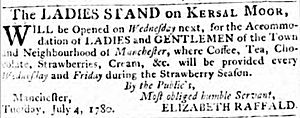
In 1781, the Raffalds' money situation improved. Elizabeth updated The Manchester Directory, and a third edition was published. She was also working on the eighth edition of The Experienced English Housekeeper. She was writing a book about midwifery (helping with childbirth) with a doctor named Charles White.
Elizabeth died suddenly on April 19, 1781. She had "spasms" and was ill for only an hour. This sounds like a stroke. Historians think the stress of their financial problems might have contributed to her early death. She was buried at St Mary's Church, Stockport on April 23.
A week after Elizabeth's death, John's creditors took action. He had to close the coffee shop and sell everything he owned to pay his debts. The copyright for the midwifery book was sold. It's not known if it was ever published with Elizabeth's name on it. John moved to London and faced more financial challenges. He later returned to Manchester and joined the Wesleyan Methodist Church. He died in December 1809, at age 85, and was buried in Stockport.
Elizabeth Raffald's Works
Cookery Book Creations
For the first edition of The Experienced English Housekeeper, Elizabeth tested all the recipes herself. For the second edition in 1771, she added 100 recipes. Some of these she had bought and not tested. But she told her readers she had "weighed them the best I could."
Historians say Elizabeth's recipes appealed to many people in England. They included dishes like "shredded calves' feet," "hot chicken pies," and "carrot puddings." She also had recipes for "poached eggs on toast," "macaroni with parmesan," and "lettuce stewed in mint and gravy." Elizabeth did not like using garlic. She preferred crisp vegetables and used grated horseradish and cayenne pepper.
The Experienced English Housekeeper only contains recipes for food and drink. Unlike many other cookery books of her time, it does not have recipes for medicines or perfumes. The book has one page with instructions for setting a table. It does not include instructions for servants. More than a third of the recipes were for sweets and desserts. These included an early recipe for "Burnt Cream" (crème brûlée). She also gave details on how to spin sugar into sugar baskets. She even explained how to make multi-layered jellies with "fish made from flummery."
Food historians say that "fantasy was Mrs. Raffald's specialty." She created recipes like "A Transparent Pudding Cover'd with a Silver Web." Another was "A Rocky Island," which had peaks of gilded Flummery and a sea made of calves-foot jelly. Some of her recipes were quite unusual, like "Rabbit Surprised." For this, after roasting, the cook was told to "draw out the jaw-bones and stick them in the eyes to appear like horns."
Elizabeth's writing style was admired. For example, she advised saving water from a pie crust because "it makes the crust sad." She also wrote that "dry salt will candy and shine like diamonds on your bacon."
According to the lexicographer John Ayto, Elizabeth Raffald was the first to write a recipe for crumpets. She also provided an early recipe in English for cooking yams. She made an early mention of barbecuing. She was ahead of her time in suggesting adding wine to dishes while they were still cooking. This was "to take off the rawness," she said.
The Manchester Directory
Elizabeth Raffald published three editions of The Manchester Directory. These came out in 1772, 1773, and 1781. To create the list, she sent "proper and intelligent Persons round the Town." They wrote down the name, business, and address of every gentleman, tradesman, and shop-keeper. This process could take weeks or months to finish.
The directory had two main parts. First, it listed the town's traders and important citizens in alphabetical order. Second, it listed Manchester's main religious, trade, charity, and government groups.
Elizabeth did not list her own shop under her name. Instead, it was listed under her husband's name: "John Raffald Seedsman and Confectioner." This was different from how she usually advertised her shop and book under her own name. The Directory listed 94 women in business. This was only 6 percent of the total listings. Of these, 46 were listed as widows.
Historians use Elizabeth Raffald's Directory to learn about women in business in the 1700s. It helps them understand that only women trading on their own, or those who were widowed or single, were likely to be listed. Women who worked with their husbands, like Elizabeth, would be listed under their husband's name.
Elizabeth Raffald's Lasting Impact
The publisher, Baldwin, released the eighth edition of The Experienced English Housekeeper soon after Elizabeth died. She had never wanted her portrait painted during her life. But Baldwin included an engraving of her in this edition. She was wearing a headdress that one of her daughters had made.
The Experienced English Housekeeper was a very popular book. It stayed in print for almost fifty years. Fifteen official editions were published, and twenty-three copied ones. The last edition came out in 1810. Elizabeth's book was also popular in colonial America. Copies were taken there by travelers, and it was printed in America too.
Elizabeth's work was copied a lot by other writers in the 1700s and 1800s. Historians say she was one of the most copied cookery book writers of her century. Writers who copied her work include Isabella Beeton in her famous Mrs Beeton's Book of Household Management (1861). Others include Mary Cole, Richard Briggs, John Townshend, Mary Smith, and John Farley.
Handwritten copies of Elizabeth's recipes have been found in family recipe books across England. Even Queen Victoria copied several of Elizabeth's recipes when she was a princess. One was for "King Solomon's Temple in Flummery."
Some believe Elizabeth Raffald invented the Eccles cake. Food writer Alan Davidson says Elizabeth's recipe for "sweet patties" was the start of the Eccles cake. Elizabeth also played a big part in how the wedding cake developed. Her recipe for "Bride Cake" was the first that looks like a modern wedding cake. Cakes were already part of weddings, but her version used what is now called royal icing over a layer of almond paste. This became the standard for British celebration cakes for the next century.
Many modern chefs and food writers admire Elizabeth Raffald. The 20th-century cookery writer Elizabeth David often mentioned Elizabeth in her articles. She included Elizabeth's recipe for apricot ice cream. In her 1984 book, An Omelette and a Glass of Wine, David included Elizabeth's recipes for potted ham with chicken, potted salmon, and lemon syllabub. In her book English Bread and Yeast Cookery (1977), David included Elizabeth's recipes for crumpets and bath buns. Food writer Jane Grigson also admired Elizabeth's work. In her 1974 book English Food, she included five of Elizabeth's recipes.
Elizabeth Raffald is quoted about 270 times in the Oxford English Dictionary. This shows how important her words were. A blue plaque marks the site of the Bulls Head pub that Elizabeth ran. It was damaged in the 1996 Manchester bombing and replaced in 2011.
In 2013, Arley Hall started serving some of Elizabeth Raffald's recipes at its restaurant. Steve Hamilton, Arley Hall's general manager, said Elizabeth is "a huge character in Arley's history." Arley Hall calls Elizabeth Raffald "the Delia Smith of the 18th century."


